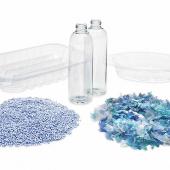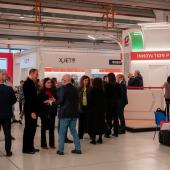From the general to the specific
An overview of the contents of the reports presented at the Economic Packaging Conference 2017, Venice, 7-8 June 2017
● Giulia Picerno (CONAI) spoke about the consortiums prevention strategy, the social and economic role of packaging in the fight against waste, involving the entire chain, from the person who designs the packaging to the person who uses it, and the results achieved (the "standard shopping cart", with its calculated environmental impact, now after two years, causes 20% less pollution a percentage rises to 30% less when considering a "cart of industrial products "). She also reiterated, among the tools available to companies to support them in sustainability innovation, the Guidelines for Facilitating Recycling of Plastic Packaging, Disclosed in 2017, with the aim of highlighting the criticality and peculiarities of the processes, as well as provide practical and effective design guidance (see www.progettarericiclo.com).
● Barbara Iascone (Italian Packaging Institute) presented the first estimates for the 2016 packaging sector, anticipating the content of "Packing in Figures" which will be presented in July. Sales are up to a good 31.7 billion euros (+ 1.9%) and production rose to 15.8 million tonnes (+ 3.2%). Dynamics that vary a lot from material to material figures (in weight) being up for exports (0%) imports and apparent usage , these trends however are not exactly matched by the figures.
A further growth (in tons) in 2017 (+ 1.6%) is indicated, which should continue into 2018 (+ 1.5%) and over the next three years (+ 1.5%), after 14 years, finally returning to pre crisis 2007 figures.
Interesting too the two focuses made on steel drums and bakery products and bread substitutes.
● Alessandra Benedini (Prometeia) outlined the scenario of the Italian manufacturing industry, which is back to drawing the country's GDP, anticipating recovery in other sectors.
Growth and competitiveness are consolidated, as shown by the rise in Italy's share of world trade, even in mature sectors; the profitability of sales in manufacturing is aligned with that of Germany and operating income also shows marginal improvement.
Over the next few years a positive trend is expected, drawn by the international market, with a recovery of emerging countries.
There are reasons for uncertainty related to the ever still weak growth dynamics of the Italian country system, to the monetary policies, the volatility of the Chinese economy, the risks of protectionism, and the global geopolitical crises.
In this context, manufacturing output growth is estimated at 1.7% in 2017 and 2018, which would however amount to a value of 13% t compared to pre-crisis figure.
As regards the packaging sector, a further rise in commodity prices is expected, which should lead to an increase in operating costs.
● Alessandro Fruscione from the tributory, law firm Santacroce & Associati talked about customs, effectively highlighting the potential economic and time saving that can derive from the optimisation of customs procedures; which can be done by using the new norms in a correct manner.
● 400 million dollars, equivalent to 100,000 tons, is what the current EMEA market for Flexible Packaging Adhesives is worth, as Mauro Masperi of Coim underlined. He then provided data on demographic phenomena, technology solutions, cost implications of the adhesive system on the final laminate ... to then show trends in terms of environmental and social sustainability and to hypothesize the products of the future: Adhesives based on renewable sources, such as polyester derivatives of adipic acid, high curing speed adhesives, isocyanates and Nias free products.
● Guido Aufdemkamp, Flexible Packaging Europe, gave a picture of the global flexible packaging market, which in 2016 surpassed 86 billion US dollars in value, of which 13.8 billion made in Europe. But above all, it listed the advantages offered by this kind of packaging and defended environmental sustainability, at any rate refuting the perception that, with the same performance, a recyclable packaging is at any rate better than a non-recyclable one. You only have to consider packing weight to show that flexible packaging, even in the case of zero recycling, is the most resource-efficient solution.
● Steel drums represent a cost-effective and environmentally-friendly choice, said Kyle Staving, ICDM. In the world, 50 million tons of products are shipped and stored in steel drums, and their widespread use makes it possible to find a close correlation between steel drum production, GDP and manufacturing indexes in the different geographic areas.
● Danilo Benvenuti reported on a recent study commissioned by Asia Pulp & Paper stating the the market for packaging for the consumption of food and beverages outside the home will increase, by 2020, 6 billion euros. The expansion of the fast food industry (Italy is third last in the world) and the fast-casual segment lead to a demand for premium “sustainable” packaging, such as the Foodpack Bio Natura Cup, a new container with a water based coating for any foodstuff. Indications were provided of the sustainability strategy pursued by the Indonesian company.
● Vincenzo Bruni, EY, spoke of packaging from the financial point of view. Positive the global growth trend of the material sector that should touch the 450 billion dollars in 2018, driven by emerging markets. The fragmentation of the industry and the need to invest in new products and markets to boost profitability led to increased M & A transactions between 2013 and 2016, 14.6% globally and 6.8% in Europe, for industrial reasons and attractive performance in terms of return on investment. Italy appears to be a particularly interesting market in this regard, in the consolidation phase thanks to the intervention of Private Equity funds.
RELATED ARTICLES: "Many the called upon, few the elect"















